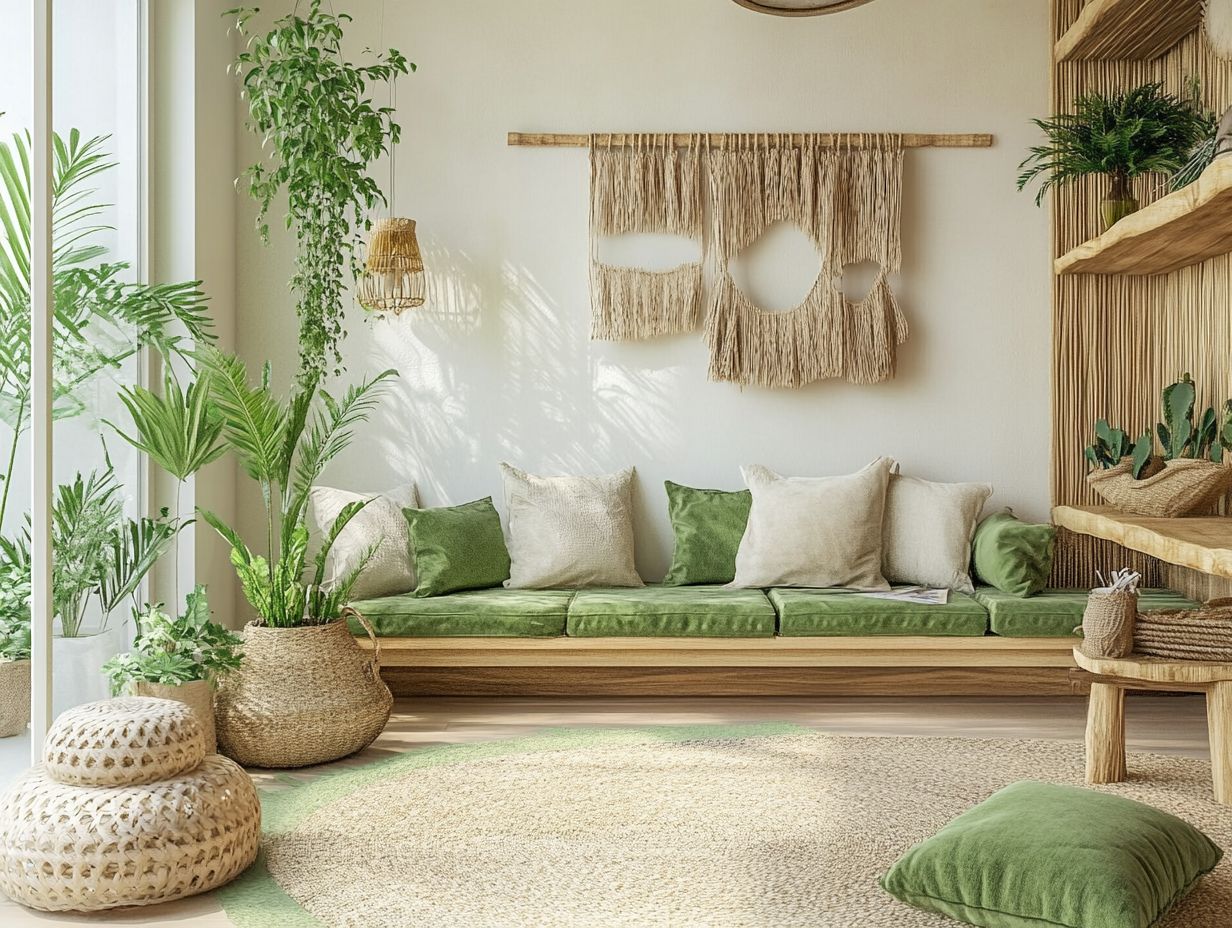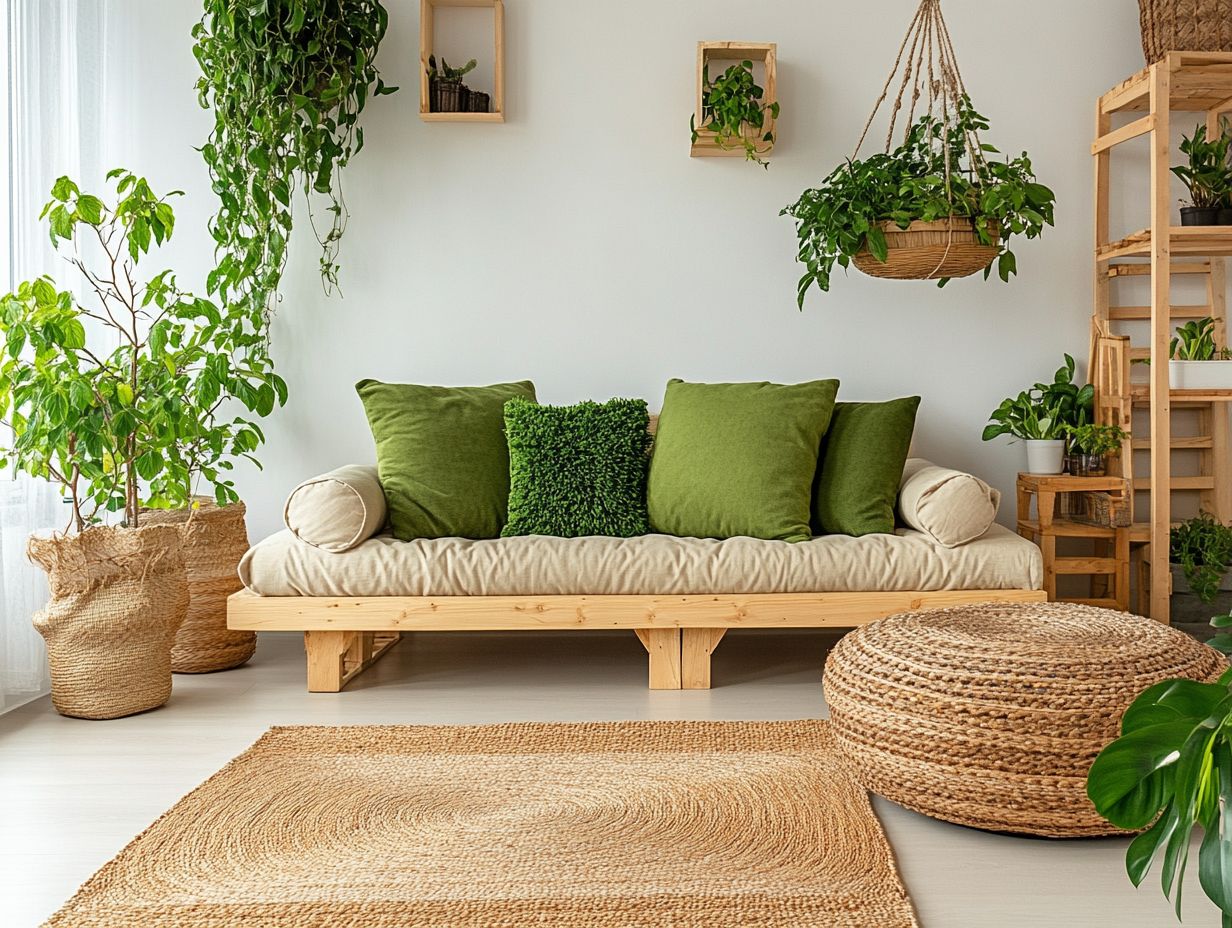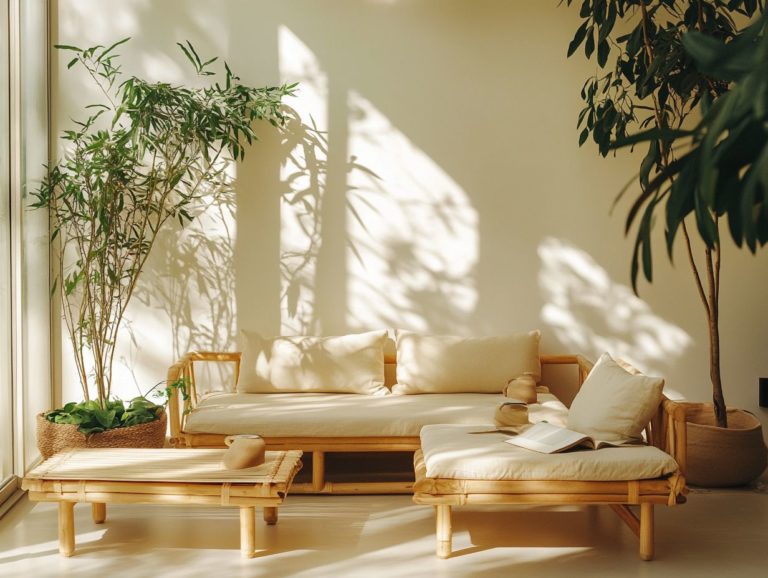How Sustainable Materials Influence Interior Design
In today’s world, where environmental concerns take center stage, sustainable materials are revolutionizing the field of interior design.
By integrating eco-friendly options into your projects, you not only contribute positively to the planet but also enhance health, wellness, and economic viability.
From eco-friendly flooring to non-toxic paints, you’ll find a wealth of sustainable materials at your disposal, along with practical tips for seamlessly incorporating them into your next design endeavor.
Explore the profound impact of sustainability on your spaces and the choices that can pave the way for a healthier, greener future.
Contents
- Key Takeaways:
- The Impact of Sustainable Materials on Interior Design
- Benefits of Using Sustainable Materials in Interior Design
- Examples of Sustainable Materials in Interior Design
- Incorporating Sustainable Materials into Design Projects
- Frequently Asked Questions
- How do sustainable materials impact interior design?
- What are some examples of sustainable materials used in interior design?
- How can incorporating sustainable materials in interior design benefit the environment?
- What are the health benefits of using sustainable materials in interior design?
- What role do sustainable materials play in creating a sustainable home?
- How can interior designers incorporate sustainable materials into their designs?
Key Takeaways:

- Sustainable materials in interior design have a positive impact on the environment, health, and economy.
- Examples of sustainable materials include eco-friendly flooring, recycled or reclaimed materials, and natural or non-toxic paints.
- Designers can incorporate sustainability by choosing and sourcing materials wisely, while implementing strategies to maximize sustainability in their projects.
The Impact of Sustainable Materials on Interior Design
The impact of sustainable materials on interior design is truly transformative. These materials elevate the aesthetic allure of spaces while minimizing the carbon footprint linked to construction and renovation.
By embracing eco-friendly materials like reclaimed wood, bamboo, and recycled glass, you can create vibrant spaces that inspire sustainable living and prioritize energy efficiency.
This shift towards sustainable practices demonstrates a heightened awareness of the environmental consequences of your choices and signifies a commitment to enhancing indoor air quality and overall wellness.
Understanding Sustainability in Design
Understanding sustainability in design requires a comprehensive approach that considers the ecological footprint of materials and the basic ideas of using sustainable materials in design.
This perspective prioritizes environmental health and highlights the crucial connections between your material choices and the well-being of the community. By integrating sustainable practices with design principles, you can significantly impact the lifecycle of materials in your projects.
This means choosing resources that minimize environmental harm while ensuring they come from suppliers who adhere to ethical standards.
Ultimately, your decisions can create a cycle of production and consumption that champions both the planet and social equity, paving the way for a healthier, more equitable future for everyone.
Benefits of Using Sustainable Materials in Interior Design
The advantages of incorporating sustainable materials in interior design are extensive, offering you many benefits. By learning how to balance aesthetics with sustainable materials, you not only contribute positively to the environment but also enhance health and wellness within your spaces.
Embracing sustainable practices leads to economic gains, making it a wise choice for both your aesthetic and your budget.
Environmental Benefits
The environmental benefits of using sustainable materials in interior design are substantial. By choosing these materials, you can embrace the rise of sustainable materials in furniture, reduce carbon emissions, decrease waste during construction, and minimize the ecological footprint throughout the lifecycle of the materials.
When you opt for reclaimed wood, recycled metal, and low-VOC paints (which means they release fewer volatile organic compounds that can harm indoor air quality), you elevate the aesthetic appeal of your spaces and contribute to lowering the overall carbon footprint tied to production and transportation.
Incorporating bamboo into your designs known for its rapid growth and impressive carbon dioxide absorption can significantly enhance energy efficiency.
Adopting sustainable practices like modular construction and optimizing material usage allows you to minimize waste, leading to a lasting positive impact on the environment. By implementing these eco-friendly materials, you pave the way for buildings that consume less energy, ultimately fostering a healthier planet.
Start your journey toward sustainable design today and transform your space!
Health and Wellness Benefits

The health and wellness benefits of incorporating sustainable materials into your interior design are remarkable. By making this choice, you enhance indoor air quality and reduce exposure to toxic chemicals typically found in conventional materials.
This is especially important today, where many people spend most of their time indoors. By selecting low volatile organic compounds (VOC) products, you can significantly reduce the risks associated with harmful emissions that often go unnoticed but can negatively impact your well-being.
Eco-friendly materials like bamboo, cork, and recycled textiles do more than beautify your spaces; they create environments that actively promote both physical and mental health.
When your living or working spaces are designed with sustainability in mind, they transform into sanctuaries that nurture comfort and well-being, fostering an overall sense of wellness.
Economic Benefits
The economic benefits of using sustainable materials in interior design are substantial, offering long-term cost savings due to the durability and energy efficiency of these products.
Investing in eco-friendly materials can lead to lower energy costs over time. Their superior insulation properties mean reduced heating and cooling needs, allowing you to keep those bills in check. For example, homes equipped with sustainable materials can achieve energy savings of up to 30% annually, as noted by the U.S. Department of Energy.
Many sustainable options also require less maintenance, translating to further savings on both materials and labor. A compelling case study from a commercial building renovation revealed a savings of 40% in maintenance costs when sustainably sourced materials were used.
These financial advantages underscore an important truth: the upfront investment in sustainability can truly pay off down the road. Start investing in sustainable materials today to start saving money tomorrow!
Examples of Sustainable Materials in Interior Design
Sustainable materials in interior design offer an array of choices that elevate both aesthetics and environmental responsibility.
Consider eco-friendly flooring options like bamboo and cork, which provide exceptional durability and bring a natural warmth to your space.
Innovative applications of recycled materials, such as reclaimed wood and recycled glass, can transform your interiors into a statement of style and sustainability.
Eco-Friendly Flooring Options
Eco-friendly flooring options abound, offering a range of sustainable materials like bamboo, cork, reclaimed wood, and natural stone, each with its unique aesthetic and functional benefits.
Bamboo stands out for its rapid growth cycle, making it a remarkably renewable resource. Cork boasts natural insulation properties that enhance energy efficiency in your home. Reclaimed wood adds character and history, breathing new life into your space while reducing waste by repurposing older materials. Meanwhile, natural stone is celebrated for its durability and timeless elegance, seamlessly fitting both rustic and modern design themes.
As you compare these options, consider factors like maintenance requirements, resilience against wear and tear, and the overall ambiance you wish to create. Whether you re envisioning a cozy living room, a stylish kitchen, or a serene bathroom, these eco-friendly choices can elevate your interior while championing sustainability.
Incorporating Sustainable Materials into Design Projects
Incorporating sustainable materials into your design projects demands a thoughtful strategy. It’s important to source options that resonate with sustainable interior design ideas for every room and sustainable practices.
This approach enhances the integrity of your work and positively contributes to the environment.
Recycled and Reclaimed Materials
Recycled and reclaimed materials, such as reclaimed wood and recycled glass, are some of the most innovative eco-friendly options in sustainable interior design. By utilizing these materials, you actively contribute to waste reduction and lower carbon footprints while fostering a circular economy that breathes new life into items that would otherwise linger in landfills.
Take reclaimed wood, for example. It can be transformed into exquisite furniture pieces or stunning flooring options that infuse any space with character and history.
On the other hand, recycled glass can be seamlessly integrated into countertops or decorative elements, offering a striking aesthetic that highlights your commitment to sustainability.
Successful projects, like incorporating reclaimed barn wood in modern urban lofts, illustrate how these materials can elevate design while being gentle on the planet.
Natural and Non-Toxic Paints

Natural and non-toxic paints, especially low VOC options, are crucial for maintaining excellent indoor air quality. They also embrace sustainable practices in your interior design choices.
These alternatives significantly reduce harmful fumes, making them safer for your home, especially with children or pets around. By choosing eco-friendly paints, you help reduce pollution and foster a healthier planet.
Natural paints also enhance your spaces’ aesthetic appeal, offering rich colors sourced from minerals and plant-based ingredients.
Renowned brands like Farrow & Ball, Benjamin Moore s Natura line, and Clare are celebrated for their commitment to sustainability and vibrant color palettes.
Whether you’re revamping your living room or decorating a child s bedroom, opting for these paints supports your health while aligning with broader environmental goals. This results in more conscious and beautiful design projects.
Tips for Choosing and Sourcing Materials
When choosing materials for your interior design projects, prioritizing sustainable practices and how to choose sustainable materials for your home can greatly elevate your design impact.
By focusing on sustainable options, you’re enhancing aesthetics and making a positive contribution to the environment. It’s essential to seek out recognized certifications, such as FSC-certified wood or organic textiles, as these labels ensure responsible sourcing practices.
Understanding the material lifecycle from production to disposal gives you the power to make informed choices that minimize waste.
Sourcing locally also reduces carbon footprints, supporting community economies while offering unique, regional options that add character to your designs.
Implementing these strategies allows you to cultivate projects that are not only visually stunning but also genuinely sustainable.
Design Strategies for Maximizing Sustainability
Designing strategies to maximize sustainability in your interior projects requires thoughtful planning and execution that prioritize eco-conscious design and waste reduction at every step.
Focusing on energy-efficient technologies, like LED lighting and high-performance HVAC systems, can significantly cut down on energy consumption. You can still create spaces that feel comfortable and inviting. Maximizing natural light enhances the ambiance while reducing your reliance on artificial lighting, harmonizing form and function seamlessly.
Incorporating natural features such as indoor plants and natural materials fosters a deeper connection to nature. This elevates the overall aesthetic and promotes well-being. These approaches minimize environmental impact and enhance the beauty and appeal of your interiors, making them stunning and responsible.
Frequently Asked Questions
How do sustainable materials impact interior design?

Sustainable materials have a major influence on interior design. They promote environmentally friendly practices, reduce carbon footprint, and create a healthier living space that contributes to a happier home!
What are some examples of sustainable materials used in interior design?
Common sustainable materials used in interior design include bamboo, reclaimed wood, recycled glass, and natural fabrics such as organic cotton and hemp. To learn more about these options, check out this guide on sustainable materials that can help create an eco-friendly home.
How can incorporating sustainable materials in interior design benefit the environment?
Using sustainable materials helps reduce the consumption of non-renewable resources, decrease waste generation, and minimize greenhouse gas emissions, positively impacting the environment.
What are the health benefits of using sustainable materials in interior design?
Sustainable materials are free from harmful chemicals and toxins, making them better for the environment and human health. They promote better air quality and reduce the risk of allergies and respiratory issues.
What role do sustainable materials play in creating a sustainable home?
Sustainable materials are essential for creating a sustainable home. They contribute to energy efficiency, conserve resources, and promote a healthier living environment for both occupants and the planet.
How can interior designers incorporate sustainable materials into their designs?
Interior designers can incorporate sustainable materials by using eco-friendly products, choosing materials with low environmental impact, and maximizing style with sustainable materials in decor while considering the entire lifecycle of the materials from production to disposal.
Want to explore more sustainable design tips or consult with an interior designer? Contact us today!






